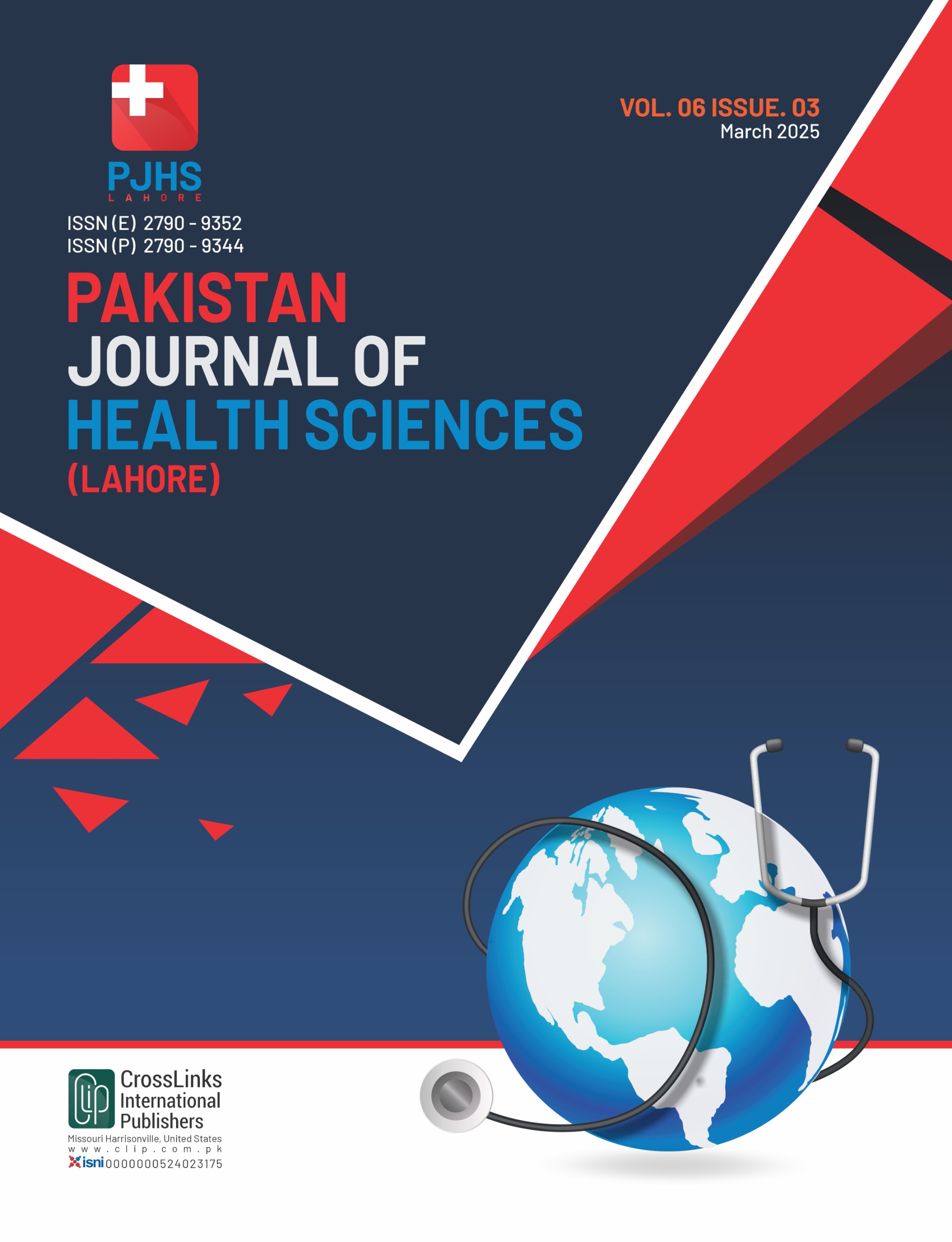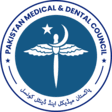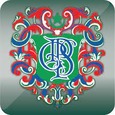Association of Partial Edentulism with Signs and Symptoms of Temporomandibular Disorders
Partial Edentulism and Jaw Disorders
DOI:
https://doi.org/10.54393/pjhs.v6i3.2838Keywords:
Partial Edentulism, Temporomandibular Disorders, Occlusal Support, Tooth Loss ImpactAbstract
Temporomandibular Joint (TMJ) is a complex joint and occlusal disharmony affects the joint health and result into temporomandibular joint dysfunction syndrome. Objective: To assess the signs and symptoms of temporomandibular joint disorders in partially edentulous patients and find out the association between TMD’s and edentulous span, tooth loss quadrant and occlusal support. Methods: 200 partially edentulous patients selected by non-probability purposive sampling and TMJ were examined for maximum mouth opening, joint deviation, tenderness of muscles of mastication and joint pain with clicking. The sample was grouped into 3 characteristics i.e.; number of partially lost teeth, number of dental quadrants with posterior teeth loss and the numbers of Occlusal Support Zones (OSZ) based on Eichner Classification system. Results: TMJ muscle pain existed in 8.0% and joint pain was 23.0%. Many patients had missing teeth in 2 quadrants 30.0% and had 5-8 numbers of missing teeth 42.5%. A3 support zone was frequently found 29.5%. Significant association of gender was found for TMJ pain, and maximum mouth opening. The tooth loss quadrant, number of partially lost teeth and occlusal support zones had significant association with muscle pain, TMJ pain with clicking and maximum mouth opening. Conclusions: It can be concluded that the partially edentulous patients frequently develop one or more signs and symptoms of TMJ disorders and number of teeth lost, number of quadrants with missing teeth and loss of occlusal support disturb the joint function and associated stomatognathic system.
References
Ravelo V, Vargas E, García Guevara H, Sacco R, Navarro P, Olate S. TMJ Replacement in Degenerative Disease: A Systematic Review. Journal of Clinical Medicine. 2025 Jan; 14(2): 580. doi: 10.3390/jcm14020580. DOI: https://doi.org/10.3390/jcm14020580
Moxley B, Stevens W, Sneed J, Pearl C. Novel diagnostic and therapeutic approaches to temporomandibular dysfunction: a narrative review. Life. 2023 Aug; 13(9): 1808. doi: 10.3390/life13091808. DOI: https://doi.org/10.3390/life13091808
Jaber M, Khalid A, Gamal A, Faisal R, Mathew A, Ingafou M. A Comparative Study of Condylar Bone Pathology in Patients with and without Temporomandibular Joint Disorders Using Orthopantomography. Journal of Clinical Medicine. 2023 Sep; 12(18): 5802. doi: 10.3390/jcm12185802. DOI: https://doi.org/10.3390/jcm12185802
Tabatabaei S, Paknahad M, Poostforoosh M. The effect of tooth loss on the temporomandibular joint space: A CBCT study. Clinical and Experimental Dental Research. 2024 Feb; 10(1): e845. doi: 10.1002/cre2.845. DOI: https://doi.org/10.1002/cre2.845
Hatfield E. An Overview of Diagnosis and Management of Temporomandibular Disorders. Journal of the California Dental Association. 2024 Dec; 52(1): 2400419. doi: 10.1080/19424396.2024.2400419. DOI: https://doi.org/10.1080/19424396.2024.2400419
Javed MU, Asim MA, Afreen Z, Afreen A, Khalil A. Association of tooth loss with temporomandibular disorders. Khyber Medical University Journal. 2020 Mar; 12(1): 29-33. doi: 10.35845/kmuj.2020.19658. DOI: https://doi.org/10.35845/kmuj.2020.19658
Srivastava KC, Shrivastava D, Khan ZA, Nagarajappa AK, Mousa MA, Hamza MO et al. Evaluation of temporomandibular disorders among dental students of Saudi Arabia using Diagnostic Criteria for Temporomandibular Disorders (DC/TMD): a cross-sectional study. BioMed Central Oral Health. 2021 Dec; 21: 1-1. doi: 10.1186/s12903-021-01578-0. DOI: https://doi.org/10.1186/s12903-021-01578-0
Kroese JM, Volgenant CM, van Schaardenburg D, Loos BG, Crielaard W, Lobbezoo F. Temporomandibular joint function, periodontal health, and oral microbiome in early rheumatoid arthritis and at-risk individuals: a prospective cohort study protocol. British Dental Journal Open. 2020 May; 6(1): 7. doi: 10.1038/s41405-020-0034-8. DOI: https://doi.org/10.1038/s41405-020-0034-8
Syed RA, Syeda AA, Katt G, Arora V. Prevalence of temporomandibular joint disorders in outpatients at Al-Badar Dental College and Hospital and its relationship to age, gender, occlusion and psychological factors. Journal of Indian Academy of Oral Medicine and Radiology. 2012 Oct; 24(4): 261-8. doi: 10.5005/jp-journals-10011-1310. DOI: https://doi.org/10.5005/jp-journals-10011-1310
Happo E, Sipola A, Näpänkangas R. Prevalence of condylar findings and their association with TMD and missing teeth-a study of 1915 dental panoramic tomograms among 46-year-old cohort subjects. CRANIO®. 2024 Aug:1-0. doi: 10.1080/08869634.2024.2385508. DOI: https://doi.org/10.1080/08869634.2024.2385508
Shah MU, Fazal M, Khuwaja SH, Awais F, Mushtaq S, Sultan A et al. Prevalence Of Tmj Disorders Among Dental Students And Its Relation To Malocclusion. Pakistan Oral & Dental Journal. 2020 Dec; 40(4): 255-9.
Saranya S, Janakiram C, Mathew A. Prevalence of temporomandibular joint dysfunction among the indigenous population of India. Journal of Oral Biology and Craniofacial Research. 2024 May; 14(3): 312-6. doi: 10.1016/j.jobcr.2024.04.002. DOI: https://doi.org/10.1016/j.jobcr.2024.04.002
Rani S, Pawah S, Gola S, Bakshi M. Analysis of Helkimo index for temporomandibular disorder diagnosis in the dental students of Faridabad city: A cross-sectional study. The Journal of Indian Prosthodontic Society. 2017 Jan; 17(1): 48-52. doi: 10.4103/0972-4052.194941. DOI: https://doi.org/10.4103/0972-4052.194941
Lekaviciute R and Kriauciunas A. Relationship between occlusal factors and temporomandibular disorders: A systematic literature review. Cureus. 2024 Feb; 16(2). doi: 10.7759/cureus.54130. DOI: https://doi.org/10.7759/cureus.54130
Zieliński G, Pająk-Zielińska B, Ginszt M. A meta-analysis of the global prevalence of temporomandibular disorders. Journal of Clinical Medicine. 2024 Feb; 13(5): 1365. doi: 10.3390/jcm13051365. DOI: https://doi.org/10.3390/jcm13051365
Rawat P, Saxena D, Srivastava PA, Sharma A, Swarnakar A, Sharma A. Prevalence and severity of temporomandibular joint disorder in partially versus completely edentulous patients: A systematic review. The Journal of Indian Prosthodontic Society. 2023 Jul; 23(3): 218-25. doi: 10.4103/jips.jips_136_23. DOI: https://doi.org/10.4103/jips.jips_136_23
Mundt T, Mack F, Schwahn C, Bernhardt O, Kocher T, John U et al. Gender differences in associations between occlusal support and signs of temporomandibular disorders: results of the population-based Study of Health in Pomerania (SHIP). International Journal of Prosthodontics. 2005 May; 18(3): 232-9.
Shet RG, Rao S, Patel R, Suvvati P, Sadar LR, Yadav RD. Prevalence of temporomandibular joint dysfunction and its signs among the partially edentulous patients in a village of North Gujarat. Journal of Contemporary Dental Practice. 2013 Nov; 14(6): 1151-5. doi: 10.5005/jp-journals-10024-1466. DOI: https://doi.org/10.5005/jp-journals-10024-1466
Zakir A, Shah MU, Iqbal M, Yasser F, Hussain MW, Riaz A. Frequency of signs and symptoms of Temporomandibular joint problems in completely Edentulous patients. Isra Medical Journal. 2020 Jan; 12: 17-21.
Amin M, Khan A, Khan MA. Frequency of common signs of temporomandibular disorders in patients with reduced occlusal support due to partial edentulism. Pakistan Oral & Dental Journal. 2019 Jul; 39(2): 206-11.
Qin H, Guo S, Chen X, Liu Y, Lu L, Zhang M et al. Clinical profile in relation to age and gender of patients with temporomandibular disorders: a retrospective study. BioMed Central Oral Health. 2024 Aug; 24(1): 955. doi: 10.1186/s12903-024-04736-2. DOI: https://doi.org/10.1186/s12903-024-04736-2
Chairunnisa R and Sihombing RJ. The association between number of tooth loss, tooth loss quadrants, and occlusal support with temporomandibular disorders in partially edentulous patients. InInternational Dental Conference of Sumatera Utara 2017 (IDCSU 2017). 2018 Feb: 255-258. doi: 10.2991/idcsu-17.2018.65. DOI: https://doi.org/10.2991/idcsu-17.2018.65
Wang MQ, Xue F, He JJ, Chen JH, Chen CS, Raustia A. Missing posterior teeth and risk of temporomandibular disorders. Journal of Dental Research. 2009 Oct; 88(10): 942-5. doi: 10.1177/0022034509344387. DOI: https://doi.org/10.1177/0022034509344387
Hiltunen K. Temporomandibular disorders in the elderly. Finland: University of Helsinki. 2004.
Bertram F, Hupp L, Schnabl D, Rudisch A, Emshoff R. Association Between Missing Posterior Teeth and Occurrence of Temporomandibular Joint Condylar Erosion: A Cone Beam Computed Tomography Study. International Journal of Prosthodontics. 2018 Jan; 31(1). doi: 10.11607/ijp.5111. DOI: https://doi.org/10.11607/ijp.5111
Ammanna S, Rodrigues A, Shetty NS, Shetty K, Augustine D, Patil S. A tomographic study of the mandibular condyle position in partially edentulous population. The Journal of Contemporary Dental Practice. 2015 Jan; 16(1): 68-73. doi: 10.5005/jp-journals-10024-1637. DOI: https://doi.org/10.5005/jp-journals-10024-1637
Downloads
Published
How to Cite
Issue
Section
License
Copyright (c) 2025 Pakistan Journal of Health Sciences

This work is licensed under a Creative Commons Attribution 4.0 International License.
This is an open-access journal and all the published articles / items are distributed under the terms of the Creative Commons Attribution License, which permits unrestricted use, distribution, and reproduction in any medium, provided the original author and source are credited. For comments













